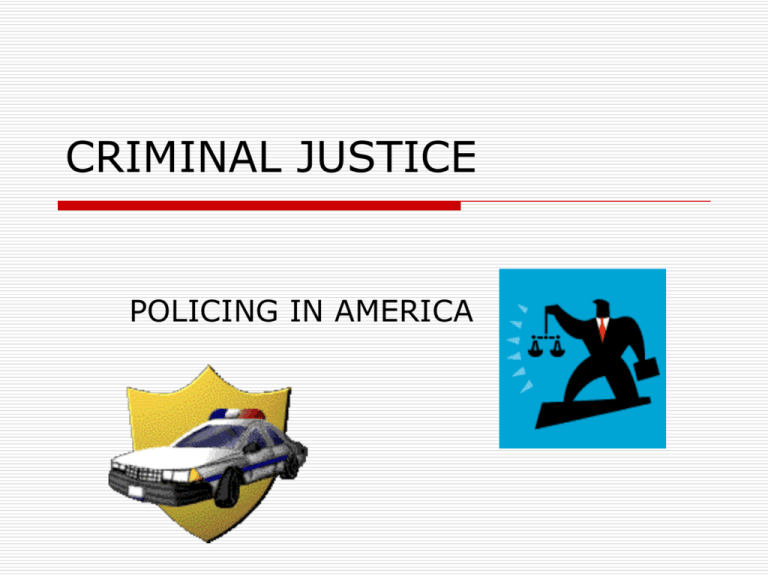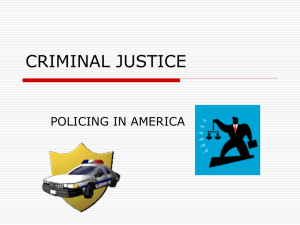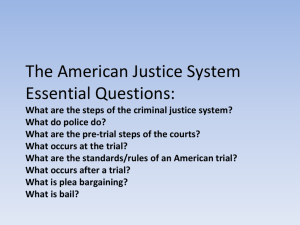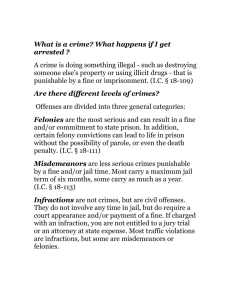Policing In America
advertisement

CRIMINAL JUSTICE POLICING IN AMERICA DUTIES OF THE POLICE 4 MAJOR DUTIES Keep the peace Apprehend violators Prevent crime Provide Social Services POLICE ARE NOT ONLY THE MOST NUMEROUS, BUT ALSO THE MOST VISIBLE OF THE CJ SYSTEM POLICE ARE CONSIDERED TO BE THE “GATE KEEPERS” They have the first contact Make decisions on if the citizen will continue in the CJ Process DISCRETION Decision making according to professional judgment based on training and experience Looks at: Seriousness of the offense Criminal hx of the offender Relationship between victims and offenders Strength of legal case against suspects and defendants SOCIAL CONTRACT Members of society are assumed to have entered an agreement to create the state and a government to acquire security and order for all Citizens surrender certain rights. In exchange for that they expect the government to provide an effective system for regulating conduct FORMAL CJ “BY THE BOOK” U.S. and State Constitutions Statutes—created by U.S. Congress, State Legislatures and City Councils Court decisions both State and Federal Written policy of CJ agencies INFORMAL CJ “CJ IN ACTION” Recognizes the need for flexibility Examples BOTH FORMAL AND INFORMAL NECESSARY SOCIAL CONTROL INFORMAL---one person to another No police involvement FORMAL—”handcuffs” Police involved OTHER SOCIAL CONTROL INSTITUTIONS RELIGIOUS GROUPS FAMILIES SCHOOLS CJ IS A STRUCTURE AND PROCESS STRUCTURE CJ Agencies Professionals in them PROCESS Decisions made by those professionals STRUCTURE Three government agencies and three levels of government Law enforcement Courts Corrections Levels of government Local State Federal STATE AND LOCAL Law Enforcement—Police departments and County Sheriff Court—Lower courts, trial courts, Court of Appeal and Probation Corrections—County jails, State prisons and Community corrections agencies FEDERAL FBI DEA ATF U.S. MARSHALS U.S. PROBATION OFFICE Approx 65 different agencies PROCESS OF CJ Series of decisions Begins with Law Enforcement then to Prosecutors then to Courts then to Corrections Criminal justice is a structure and a process Parts are interdependent Decisions affect each other Not always cohesive HYDRAULIC EFFECT Discretion can shift from one agency to another DECISIONS PRIOR TO CJ PROCESS Legislatures decide what will be a crime Any human conduct that violates a criminal law and is subject to punishment FOUR TYPES OF LAW SUBSTANTIVE LAW PROCEDURAL LAW CIVIL LAW CASE LAW SUBSTANTIVE LAW CRIMINAL STATUTES POLICE CANNOT ARREST CITIZENS UNLESS THEY VIOLATE A SUBSTANTIVE LAW PROCEDURAL LAW Laws that dictate how police will do their job For example: Use of Force CIVIL LAW Regulate social interactions arising from private, commercial or contractual relations For example: City Building Codes CASE LAW Written opinions of the courts For example: Miranda rights DEFINING CRIME—SUBSTANTIVE LAWS MALA IN SE—latin term Wrong in themselves Broad agreement in society that certain actions are so harmful that they must be punished MALA PROHIBITA Laws that are enacted even though people in society may disagree about the harmfulness of certain acts 11 STEPS OF THE CJ PROCESS Victims report crimes Law Enforcement investigate Police apprehend and arrest Prosecutor charges Suspect---guilty---plea bargain Suspect—not guilty---trial Judge sentences Convicted have appeals Convicted goes to corrections Convicted awarded privileges or punishments Convicted paroled Step 11 MODELS OF CRIMINAL JUSTICE Wedding Cake Seriousness of charge Past criminal record Relationship of victim to offender Was victim injured Gun used Strength of case Funnel Opposite shape of Wedding Cake Sorting process Case attrition “Letting criminals off??” Arrest does not mean guilt WEDDING CAKE Celebrated cases Real crimes Misdemeanors FUNNEL Lots of cases Few go to trial CJ MODELS CON’T Crime control model Focus on need to protect people/property For the good of society Emphasizes police investigation and guilty pleas Not concerned with fairness Assembly line Due process model Focus on rights of individuals Obstacle course Adversary process—get to the truth by fighting in court Formal rules of criminal procedure CRIME CONTROL MODEL Assembly line DUE PROCESS OBSTACLE COURSE PENDULUM Crime control/due process PENDULUM Where are we now???? USA PATRIOT ACT OF 2001 QUALITIES OF A POLICE OFFICER CURIOUS ABLE TO PERCEIVE DANGER PERSPECTIVE EMPATHETIC COMPASSIONATE Decisive Have self-control Must be able to adapt Varied approaches to unique problems HOW DO YOU LEARN THESE QUALITIES??? PROCESS IN A NUTSHELL Citizens report crimes Police investigate Police apprehend and arrest Prosecutor charges suspects Suspect—guilty—plea bargain Suspect—not guilty—trial Judge sentences Convicted have appeals Convicted goes to corrections Convicted awarded privileges or punished Convicted paroled











